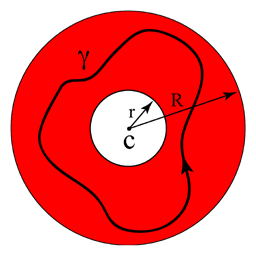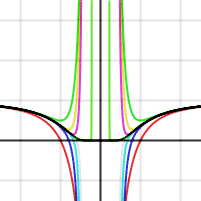Laurent series
|
|

In mathematics, the Laurent series of a complex function f(z) is a representation of that function as a power series which includes terms of negative degree. It may be used to express complex functions in cases where a Taylor series expansion cannot be applied. The Laurent series was named after and first published by Pierre Alphonse Laurent in 1843. Karl Weierstrass discovered it first in 1841 but did not publish it.
The Laurent series for a complex function f(z) about a point c is given by:
- <math>f(z)=\sum_{n=-\infty}^\infty a_n(z-c)^n<math>
where the an are constants, defined by a path integral which is a generalization of Cauchy's integral formula:
- <math>a_n=\frac{1}{2\pi i} \oint_\gamma \frac{f(z)\,dz}{(z-c)^{n+1}}.\,<math>
The path of integration γ is counterclockwise around a closed, rectifiable path containing no self-intersections, enclosing c and lying in an annulus A in which f(z) is holomorphic. The expansion for f(z) will be valid anywhere inside this annulus. The annulus is shown in red in the diagram on the right, along with an example of a suitable path of integration labelled γ. In practice, this formula is rarely used because the integrals are difficult to evaluate; instead, one typically pieces together the Laurent series by combining known Taylor expansions. The numbers an and c are most commonly taken to be complex numbers, although there are other possibilities, as described below.
Convergent Laurent series
Laurent series with complex coefficients are an important tool in complex analysis, especially to investigate the behavior of functions near singularities.
Consider for instance the function f(x) = e−1/x² with f(0) = 0. As a real function, it is infinitely often differentiable everywhere; as a complex function however it is not differentiable at x = 0. By plugging −1/x2 into the series for the exponential function, we obtain its Laurent series which converges and is equal to f(x) for all complex numbers x except at the singularity x=0. The graph opposite shows e−1/x² in black and its Laurent approximations
- <math>\sum_{j=0}^n(-1)^j\,{x^{-2j}\over j!}<math>
for n = 1, 2, 3, 4, 5, 6, 7 and 50. As n → ∞, the approximation becomes exact for all (complex) numbers x except at the singularity x = 0.
More generally, Laurent series can be used to express holomorphic functions defined on an annulus, much as power series are used to express holomorphic functions defined on a disc.
Suppose ∑−∞ < n < ∞ an(z − c)n is a given Laurent series with complex coefficients an and a complex center c. Then there exists a unique inner radius r and outer radius R such that:
- The Laurent series converges on the open annulus A := {z : r < |z − c| < R}. To say that the Laurent series converges, we mean that both the positive degree power series and the negative degree power series converge. Furthermore, this convergence will be uniform on compact sets. Finally, the convergent series defines a holomorphic function f(z) on the open annulus.
- Outside the annulus, the Laurent series diverges. That is, at each point of the exterior of A, the positive degree power series or the negative degree power series diverges.
- On the boundary of the annulus, one cannot make a general statement, except to say that there is at least one point on the inner boundary and one point on the outer boundary such that f(z) cannot be holomorphically continued to those points.
It is possible that r may be zero or R may be infinite; at the other extreme, it's not necessarily true that r is less than R. These radii can be computed as follows:
- <math>r = \limsup_{n\rightarrow\infty} |a_{-n}|^{1 \over n}<math>
- <math>{1 \over R} = \limsup_{n\rightarrow\infty} |a_n|^{1 \over n}<math>
We take R to be infinite when this latter lim sup is zero.
Conversely, if we start with an annulus of the form A = {z : r < |z − c| < R} and a holomorphic function f(z) defined on A, then there always exists a unique Laurent series with center c which converges (at least) on A and represents the function f(z).
As an example, let
- <math>f(z) = {1 \over (z-1)(z-2i)}<math>
This function has singularities at z = 1 and z = 2i, where the denominator of the expression is zero and the expression is therefore undefined. A Taylor series about z = 0 (which yields a power series) will only converge in a disc of radius 1, since it "hits" the singularity at 1.
However, there are three possible Laurent expansions about z = 0:
- One is defined on the disc where |z| < 1; it is the same as the Taylor series.
- One is defined on the annulus where 1 < |z| < 2, caught between the two singularities.
- One is defined on the infinite annulus where 2 < |z| < ∞.
The case r = 0, i.e. a holomorphic function f(z) which may be undefined at a single point c, is especially important.
The coefficient a-1 of the Laurent expansion of such a function is called the residue of f(z) at the singularity c; it plays a prominent role in the residue theorem.
For an example of this, consider
- <math>f(z) = {e^z \over z} + e^{1 \over z}<math>
This function is holomorphic everywhere except at z = 0. To determine the Laurent expansion about c = 0, we use our knowledge of the Taylor series of the exponential function:
- <math>f(z) = \cdots + \left ( {1 \over 3!} \right ) z^{-3} + \left ( {1 \over 2!} \right ) z^{-2} + 2z^{-1} + 2 + \left ( {1 \over 2!} \right ) z + \left ( {1 \over 3!} \right ) z^2 + \left ( {1 \over 4!} \right ) z^3 + \cdots<math>
and we find that the residue is 2.
Formal Laurent series
Formal Laurent series are Laurent series that are used without regard for their convergence. The coefficients ak may then be taken from any commutative ring K. In this context, one only considers Laurent series where all but finitely many of the negative-degree coefficients are zero. Furthermore, the center c is taken to be zero.
Two such formal Laurent series are equal if and only if their coefficient sequences are equal. The set of all formal Laurent series in the variable x over the coefficient ring K is denoted by K((x)). Two such formal Laurent series may be added by adding the coefficients, and because of the finiteness of the negative-degree coefficients, they may also be multiplied using convolution of the coefficient sequences. With these two operations, K((x)) becomes a commutative ring.
If K is a field, then the formal power series over K form an integral domain K[[x]]. The field of quotients of this integral domain can be identified with K((x)).

